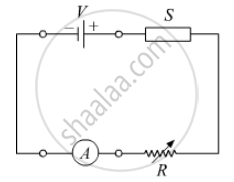Advertisements
Advertisements
प्रश्न
In the following diagram 'S' is a semiconductor. Would you increase or decrease the value of R to keep the reading of the ammeter A constant when S is heated? Give reason for your answer.

उत्तर
As the semiconductors at room temperature act as insulators so they offer very high resistance value. But with the increase in temperature, they start conducting by decreasing the energy-gap and hence they offer less resistivity. So, the resistivity of semiconductors decreases with the increase in temperature and as a result resistance also decreases.
So to maintain the constant reading on the ammeter, we should increase the value of variable resistance R to compensate with the decreased value of resistance for semiconductor.
APPEARS IN
संबंधित प्रश्न
The power delivered in the plate circular of a diode is 1.0 W when the plate voltage is 36 V. Find the power delivered if the plate voltage is increased to 49 V. Assume Langmuir-Child equation to hold.
Diffusion in a p-n junction is due to ______.
Of the diodes shown in the following diagrams, which one is reverse biased?
Use a transistor as an amplition
On increasing the reverse biases voltage to a large value in a P – N junction diode-current
Consider an npn transistor with its base-emitter junction forward biased and collector base junction reverse biased. Which of the following statements are true?
- Electrons crossover from emitter to collector.
- Holes move from base to collector.
- Electrons move from emitter to base.
- Electrons from emitter move out of base without going to the collector.
In the depletion region of a diode ______.
- there are no mobile charges.
- equal number of holes and electrons exist, making the region neutral.
- recombination of holes and electrons has taken place.
- immobile charged ions exist.
Describe briefly the following term:
breakdown voltage in reverse biasing
With reference to a semiconductor diode, define the potential barrier.
What is meant by forward biasing of a semiconductor diode?
